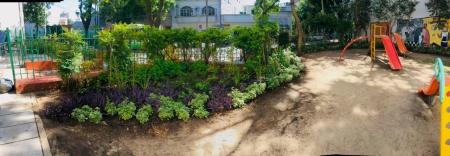
Area characterisation:
Buenos Aires’s overall levels of air pollution exceed WHO air quality guidelines, and in some neighbourhoods they are three times acceptable levels (Greenpeace Argentina, 2018). Despite this, local policy engagement with air pollution is incipient (Abrutzky et al., 2014; Murgida et al., 2013). Yet social awareness on the issue is growing (cf. Greenpeace Argentina, 2018). This inspired the Breathe/Respirar Project (BRP) an international collaboration designed for knowledge exchange and mutual learning rather than one-way technical assistance from the UK. Locally led by the Landscape Architecture programme at the University of Buenos Aires, the initiative received enthusiastic initial support from academics of multiple disciplines, government institutions, professional and business circles and advocacy groups.
Objective:
Breathe/Respirar Project (BRP) began with a clear objective of addressing local air quality concerns in a school community of Sheffield, UK. The project’s implementation in Buenos Aires required a participatory process with several rounds of trial and error to identify and enrol stakeholders in a broadly defined green infrastructure initiative.
Financing:
British Council and British Academy
Potential impacts/benefits:
With the first living fence planted between November 2019 and February 2020, some early impacts and benefits were identified:
- Engaging City Government: The project obtained recognition from the City Council and engaged with multiple departments within local government, most notably the Buenos Aires Ministry of Education and its sustainability education programme.
- The Breathe Deep Experimental Training Course provided an opportunity for people who are working, or hoping to work, in landscaping to receive training and practical experience of creating living fences and school yards.
- Applied learning with University of Buenos Aires students involved them in research, analysis, design and implementation of the first living fence and school yard in Buenos Aires.
- School-based activities with children and teachers: 5th year primary schoolchildren took part in an arts-based workshop facilitated by environmental educators using art, music and games.
- Exchange and collaboration: in order to extend the network of academic and professional collaboration, UBA and the Sociedad Central de Arquitectos convened an international conference in Buenos Aires on green infrastructure in Latin American cities.
Benefits:
- Increase Biodiversity.
- Increase quality and quantity of green and blue infrastructures.
- Improve air quality.
- Changing image of the urban environment.
- Increase communities’ sense of ownership.
- Air/ambient quality (to reduce UHI effect and/or to improve air/ambient quality).
Actions:
The implementation process in Buenos Aires drew on international lessons with Urban Living Labs (ULL), local expertise on pluralistic environmental education; and social science insights on how the politics of urban greening play out in the city given its salient inequalities and fragmentary development.
The design involved planting in three strata:
1) Ivy (Hedera helix) constituted the first line between the exterior and the interior of the schoolyard. This species was chosen because it is a hardy, low maintenance plant that adapts easily to different sites. It has minimal water requirements and evergreen foliage. The ivy made up the first layer of the living fence. It was compactly mounted on top of an existing railing, which ensured that the plants grew vertically.
2) Non-invasive canes (Phyllostachys aurea and Bambusa multiplex) constitute the second level of the living fence, providing density and height. In our choice of species, we prioritized rapid growth while avoiding invasiveness so as to limit competition with the plants in the third strata of our design.
3) The third strata was made up of plants that aligned with our approach concerning landscape architecture that is aesthetic, recreational, sensory and has environmental benefits and/or environmental education value, such as re-connecting with nature and increasing biodiversity.
Transferability of result:
Transferability is certainly possible, as the project implementation in Buenos Aires correspond to an original idea brought from Sheffield, UK. Once it was framed in the local socio-spatial context, the project has run well. In the same sense, it can be replicated in other areas of the city and in other cities. There is a lot of exciting work ahead with living fences in Buenos Aires and beyond. We need to produce clear and robust evidence from urban living lab activities to inform policy shifts and continuing governmental engagement. Additionally, we plan to explore their role in site-specific and creative pedagogies of urban environmental quality in early education.
Lessons learnt:
We still have much to learn about living fences, from the optimum design specifications for air quality improvement to the manifold social and ecological co-benefits that this layer of vegetation enhancement yields. Whereas the former has a clear site-specific focus, which in the case of school yards is of critical importance to secure environmental health for children, the latter can and must accrue at multiple scales, and link as much as possible with broader networks of Nature-Based Solutions.
Organisations:
Breathe/Respirar Project https://www.aguayverde.com.ar/proyecto_respirar/
Client:
Buenos Aires University and Sheffield University.
Design team:
The landscape design for the pilot project was developed by Landscape Architecture staff and students from the University of Buenos Aires (UBA) with input from international partners.
Contacts:
Global goals:
-
3. Good Health and well being
-
11. Sustainable cities and communities
-
13. Climate action
-
15. Life on land
NBS goals:
- Enhancing sustainable urbanization
- Developing climate change mitigation
- Urban regeneration through nature-based solutions
- Nature-based solutions for improving well-being in urban areas
NBS benefits:
- Developing climate change mitigation
- Enhancing sustainable urbanisation
- Increase communities’ sense of ownership
- Increase social interaction
- Social inclusion
- Social learning about location & importance of NBS
Publications and reports:
Amaya-Espinel J.D, Hernández-Garcia J. & Cruz-Suárez M.A. 2021. State of the art, good practices and NbS typology in European Union and Latin America cities. Report D2.1 v1.1. European Union’s Horizon 2020 research and innovation programme under grant agreement no. 867564 tinyurl.com/conexus-project.